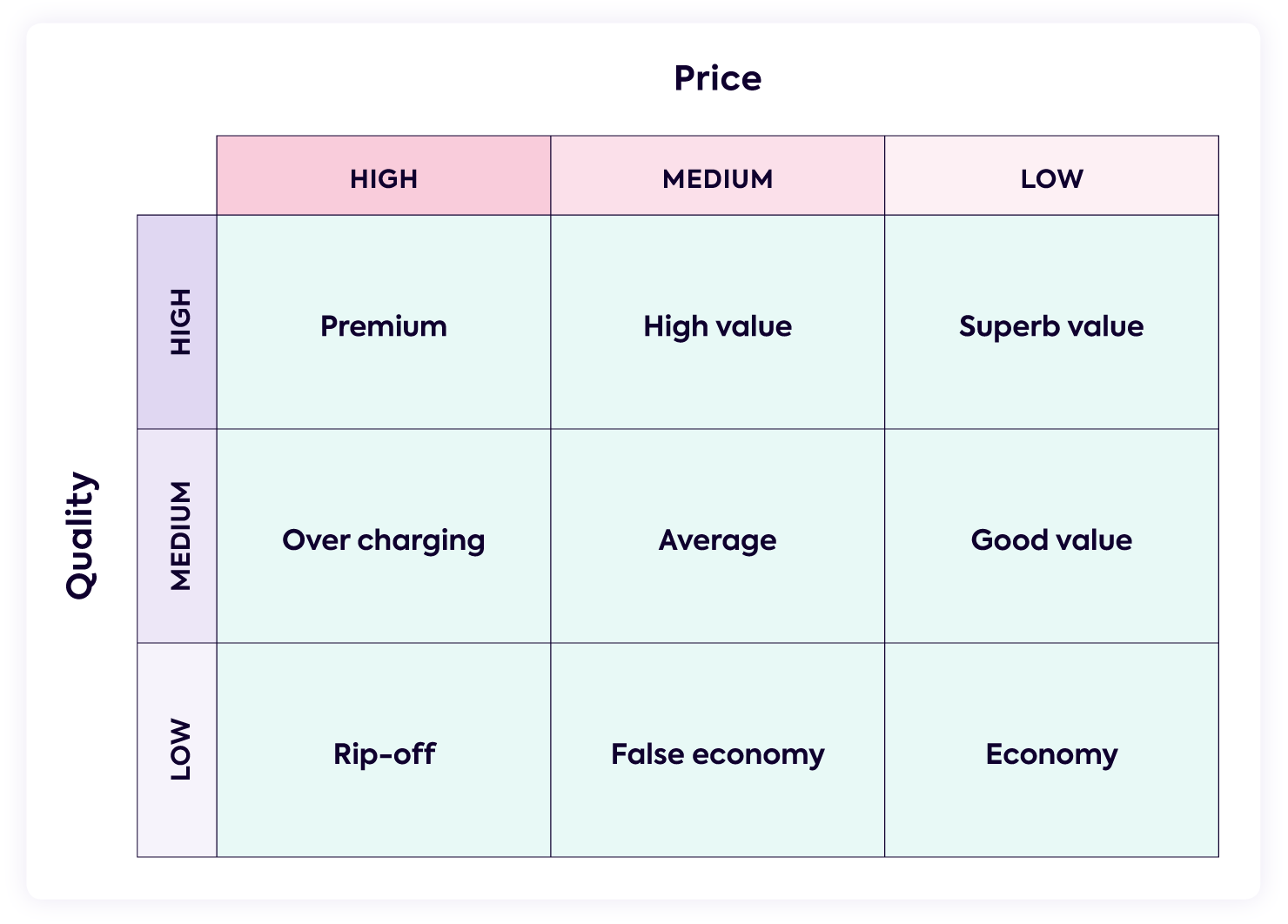We know! Pricing is hard. Thankfully, there are lots of different approaches and tools to help you get to the point of the perfect pricing. In this article we’ll take a look at one of those called Kolter’s Pricing Strategies. It helps you consider different options for how you position yourself in a market.
So let’s take a look…
What are Kotler’s Pricing Strategies?
Kotler’s Pricing Strategies are a collection of strategic options for your price points. The tool maps out 9 possible options by cross referencing quality and price point in a 3×3 matrix.
The pricing strategies listed as:
- Premium Pricing
- High Value
- Superb Value
- Good Value
- Average
- Over Charging
- Economy
- False Economy
- Rip Off
It’s sometimes seen as a form of Competitive Based Pricing, as the product or service is often measured in relation to others in the market.
Premium Pricing in the Kotler’s Pricing Strategies
This price point is where the quality is deemed to be high and the price point is deemed to be high. It can be used for new innovative products, where competition is low, or where a brand is positioning itself as premium.
Premium Pricing Pros:
- High margins
- Helps the perception of high quality
Premium Pricing Cons:
- Tricky to maintain longer term
- Market share may be damaged
High Value Pricing in the Kotler’s Pricing Strategies
If your product or service is high quality but a medium price point then the strategy is High Value, where the customer perceives they’re getting a good price point. It’s a common strategy for companies where the market has a number of players and so the premium price cannot be maintained.
High Value Pricing Pros:
- Margins could be higher
- Customer perceives a good value
High Value Pricing Cons:
- Investment required to develop high quality
Superb-Value Pricing in the Kotler’s Pricing Strategies
A price point that is low for a quality that is high is classified as Superb-Value Pricing and can be seen as a way to maximise growth within a market. It can be termed as “buying market share” or running at a loss to acquire customers. Unless there’s a long term plan on how to further generate revenue or change the revenue model, the business will require significant efficiencies to run this pricing model well.
Superb-Value Pricing Pros:
- Seen as great value for customers
- Can result in rapid market growth
Superb-Value Pricing Cons:
- Risky for margins
- Can be seen as “too good to be true” by customers
Good-Value Pricing in the Kotler’s Pricing Strategies
Good-Value Pricing is where the quality of a product or service is medium, with the price point being low. This is a less risky approach to growing market share via price than Superb-Value, but is easier for your competitors to address.
Good-Value Pricing Pros:
- Less risky way to grow market share via pricing
- Good perception from customers
Good-Value Pricing Cons:
- Margins are impacted
- Difficult to judge the level of quality needed
Average Pricing in the Kotler’s Pricing Strategies
Average is medium quality and medium price point. In this scenario the price will be expected by the customer, with them not thinking it’s a particularly good or bad value deal.
Average Pricing Pros:
- No surprises for the customer
- Easy to predict sales
Average Pricing Cons:
- Not going to produce high margins
- No advantage in terms of market share growth
Over Charging Pricing in the Kotler’s Pricing Strategies
If your product is medium quality and yet highly priced then the classification is Over Charging. This is a difficult position to be in and while it’s possible to maintain if choice is limited for customers, it opens you up to competitors and new entrants taking your market share.
Over Charging Pricing Pros:
- High margins
Over Charging Pricing Cons:
- Company reputation
- Requires either limited option for customers or high value brand
Economy Pricing in the Kotler’s Pricing Strategies
The Economy price point is where both the quality and price is low and the price. This is a common “budget price” strategy seen, with examples being certain airlines or supermarkets, but comes with the risk of being a race to the bottom.
Economy Pricing Pros:
- There’s always a market for low value/low cost
- Hard for competitors to compete
Economy Pricing Cons:
- Low margins / need high volume
- Can become crowded if all players cut their prices
False Economy Pricing in the Kotler’s Pricing Strategies
A False Economy category is where your quality is low, but your price point is mid-level. This means the pricing is classified as overpriced, and so you’re at risk. If you’re in this area it’d be better to move towards Economy pricing or Average pricing.
False Economy Pricing Pros:
- Hesitant to add any, but this price point would be good for margins
False Economy Pricing Cons:
- Customer perception
- Risk of market share loss
- Brand reputation
Rip Off Pricing in the Kotler’s Pricing Strategies
Rip Off is the worst price point to be in for your reputation, brand, and longevity. It’s where your price point is high and your quality is low.
Rip Off Pricing Pros:
- Again we’d not recommend this, but ROP would have high margins
False Economy Pricing Cons:
- Customer perception
- Risk of market share loss
- Brand reputation
- Unhappy customers
What are the advantages of Kotler’s Pricing Strategies?
The advantages of Kotler’s Pricing Strategies are:
- It’s a simple model to use
- It provides various options
- It gives guidance to where there are risks longer term
What are the disadvantages of Kotler’s Pricing Strategies?
Some factors to consider when using this model are:
- It doesn’t provide market analysis insight
- Quality measurement is subjective
Can you have two pricing strategies at once?
Yes, it’s perfectly possible to have two pricing strategies at the same time. Companies with multiple revenue streams often employ different strategies for each one to maximise growth.
What tools go well with Kotler’s Pricing Strategies?
Take a look at Meyer’s Revenue Model Framework that helps you understand how to position your product. It may also be useful to review our pricing strategy guide. Another framework that is helpful is Porter’s Five Forces, which looks at the profitability pressures within your marketplace.
What are the alternatives to Kotler’s Pricing Strategies?
Although not a direct alternative, Bowman’s Strategy Clock provides different options for a market position.
Who invented Kotler’s Pricing Strategies?
Kotler’s Pricing Strategies was developed by Philip Kotler, a Professor of International Marketing and thought leader in the marketing industry.














